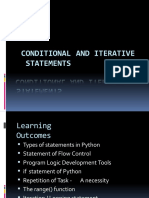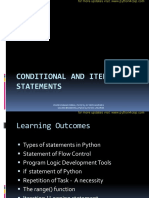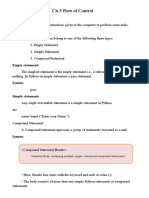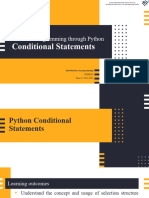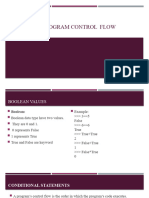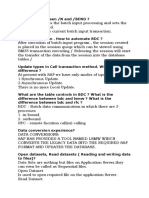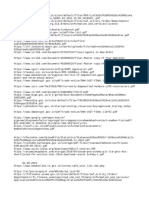CONDITIONALAND
ITERATIVE STATEMENTS
Learning
Outcomes
Types of statements in
Python
Statement of Flow Control
Program Logic Development
Tools
if statement of Python
Repetition of Task - A
necessity
The range() function
Iteration / Looping
Types of Statement in
Python
Statements are the instructions given
to computer to perform any task.
Task may be simple calculation,
checking the condition or repeating
action.
Python supports 3 types of
statement:
Empty statement
Simple statement
Compound statement
Empty
Statement
It is the simplest statement i.e. a
statement which does nothing. It is
written by using keyword – pass
Whenever python encountered pass
it does nothing and moves to next
statement in flow of control
Required where syntax of python
required presence of a statement
but where the logic of program does.
More detail will be explored with
loop.
Simple
Statement
Any single executable statement in
Python is simple statement. For e.g.
Name = input(“enter your name “)
print(name)
Compound
Statement
It represent group of statement
executed as unit. The compound
statement of python are written in a
specific pattern:
Compound_Statement_Header :
indented_body containing
multiple simple or
compound statement
Compound Statement
has:
Header which begins with
keyword/function and ends with
colon(:)
A body contains of one or more
python statements each indented
inside the header line. All statement
in the body or under any header
must be at the same level of
indentation.
Statement Flow
Control
In python program statement may
execute in a sequence, selectively
or iteratively.
programmi Python3 Control
support
ng Flow
statements
:
1. Sequence
2. Selection
3. Iteration
Sequence
It means python statements are
executed one after another i.e. from
the first statement to last statement
without any jump.
Selection
It means execution of statement will
depend upon the condition. If the
condition is true then it will execute
Action 1 otherwise Action 2. In
Python we use if to perform
selection
Selection
Action
1
Conditio True Statemen Statemen
n? t1 t2
Fals
e
Statement
1
Action
Statemen
2
t2
Selection
We apply Decision making or
selection in our real life also like if
age is 18 or above person can vote
otherwise not. If pass in every
subject is final exam student is
eligible for promotion.
You can think of more real life
examples.
Iteration - Looping
Iteration means repeating of statement
depending upon the condition. Till the
time a condition is True statements are
repeated again and again. Iteration
construct is also known as Looping
construct
In real world we are using Looping
construct like learning table of any
number we multiply same number from
1 to 10, Washing clothes using washing
machine till the time is over, our school
Iteration - Looping
Fals
Conditio e Exit from
n? iteration
Tru
e
Statemen
t1
Loop Python supports
Action
Body
Statemen for and while
t2 statement for
2
Looping construct
Error and
Exceptions
Error means ‘bugs’ in a program, i.e.
either program is not running or
running but not producing the
expected output.
Exceptions are those errors which
appears during the execution time of
program i.e. there are some
exceptional condition in which program
is not successfully executing.
Types of Error:
Syntax Error
Semantic Error
Logical Error
Runtime Error
for more updates visit: www.python4csip.com
Syntax
Error
It occurs before the execution of program.
It occurs due to violation of programming
language rule for e.g. missing parenthesis,
incorrect use of operators etc.
Syntax error
due to missing
parenthesis
VINOD KUMAR VERMA, PGT(CS), KV OEF
KANPUR &
SACHIN BHARDWAJ, PGT(CS), KV NO.1
Semantic
Error
occurs when statements are not
meaningful. For
e.g. ‘Sita Plays Piono’ is syntactically
and semantically correct but ‘Piono
plays Sita’ is syntactically correct but
semantically incorrect. Take another
exampe : X*Y=Z is semantically
incorrect because expression cant
comes before the assignment operator;
Logical
Error
occurs when program is executing successfully
but not producing the correct output. It is one
of the most difficult error to trace and debug.
It may occurs by use or wrong operators like
use of ‘*’ in place of ‘+’ Or wring C=B/A in
place of C=A/B etc. With input 20 as
n1 and 10 as
n1, expected
result was 2
but output is
0.5, because
expression is
n2/n1 not n1/n2
Runtime
Error
It occurs during the execution of program.
It is also known as exception.
It occurs due to some wrong operation, input,
etc. the
most common runtime error is “divide by
zero”
Exception handling (try &
except)
try : this block is used for writing those
statements in which exception may occurs.
except : this block is used for handling the
exception
occurs in try block i.e. decides what to do with
exception.
if Statement of
Python
‘if’ statement of python is used to
execute statements based on
condition. It tests the condition and
if the condition is true it perform
certain action, we can also provide
action for false situation.
if statement in Python is of many
forms:
if without false statement
if with else
if with elif
Simple
In the simplest
“if” form if statement in
Python checks the condition and
execute the statement if the
condition is true and do nothing if
the condition is false.
Syntax: All statement
belonging to
if condition: if must have
same
Statement indentation
1 level
** if Statement
statement is compound statement
havings ….header and a body containing
intended statement.
Points to remember with
“if”
It must contain valid condition
which evaluates to either True or
False
Condition must followed by Colon
(:) , it is mandatory
Statement inside if must be
at same indentation level.
Input monthly sale of employee and
give bonus of 10% if sale is more than
50000 otherwise bonus will be 0
bonus = 0
sale = int(input("Enter Monthly
Sales :")) if sale>50000:
bonus=sale * 10 /100
print("Bonus = " + str(bonus))
1.WAP to enter 2 number and print the
largest number
2.WAP to enter 3 number and print the
largest number
1. WAP to enter 2 number and print the
largest number
n1 = int(input("Enter first
number "))
n2 = int(input("Enter second
number ")) large = n1
if (large<n2):
large=n2
print("Largest number is ",
large)
2. WAP to enter 3 number and print the
largest number
n1 = int(input("Enter first
number "))
n2 = int(input("Enter second
number "))
n3 = int(input("Enter third
number ")) large = n1
if (large<n2):
large=
n2
if(large<n3
if with else
if with else is used to test the
condition and if the condition is True
it perform certain action and
alternate course of action if the
condition is false.
Syntax:
if condition:
Statements
else:
Statements
Input Ageof person and print whether
the person is eligible for voting or not
age = int(input("Enter your
age ")) if age>=18:
print("Congratulation!
you are eligible for
voting ")
else:
print("Sorry! You are
not eligible for voting")
To
Do…
1. WAP to enter any number and check
it is even or odd
2. WAP to enter any age and check it is
teenager or not
3. WAP to enter monthly sale of
Salesman and give him commission
i.e. if the monthly sale is more than
500000 then commision will be 10%
of monthly sale otherwise 5%
4. WAP to input any year and check it is
Leap Year or Not
5. WAP to Input any number and
print Absolute value of that
number
6. WAP to input any number and check
it is positive or negative number
if with elif
if with elif is used where multiple chain of
condition is to be checked. Each elif must
be followed by condition: and then
statement for it. After every elif we can
give else which will be executed if all the
condition evaluates to false
Syntax:
if condition:
Stateme
nts elif
condition:
Stateme
nts elif
condition:
Sta
tements
Input temperature of water and print its
physical state
temp = int(input("Enter temperature of
water ")) if temp>100:
print("Gaseous
State") elif temp<0:
print("Solid
State")
else:
print("Liquid
State")
Input 3 side of triangle and print the type of
triangle –
Equilateral, Scalene, Isosceles
s1 = int(input("Enter
side 1")) s2 =
int(input("Enter side
2")) s3 =
int(input("Enter side
3")) if s1==s2==s3:
print("Equilater
al") elif s1!=s2!
=s3!=s1:
print("Sca
lene")
else:
Program to calculate and print roots of a
quadratic equation: ax2+bx+c=0(a!=0)
import math
print("For quadratic equation, ax**2 +
bx + c = 0, enter coefficients ")
a=
int(input("enter
a")) b =
int(input("enter
b"))
c=
int(input("enter
c")) if a==0:
Program to calculate and print roots of a
quadratic equation: ax2+bx+c=0(a!=0)
if delta >0:
root1=(-b+math.sqrt(delta))/
(2*a)
root2=(-b-math.sqrt(delta))/
(2*a) print("Roots are Real
and UnEqual")
print("Root1=",root1,"Root2="
,root2)
elif delta==0:
root1=-b/(2*a)
print("Roots are Real and
Equal")
To
Do…
1. WAP to enter marks of 5 subject and calculate total,
percentage and also division.
Percentage Division
>=60 First
>=45 Secon
>=33 d
otherwi Third
2.WAPseto enter any numberFailed
and check it is positive,
negative or zero
number
3.WAP to enter Total Bill amount and calculate discount
as per given table and also calculate Net payable
amount (total bill – discount)
>=200 15% of Total
Total
00 Bill Discount
Bill 10% of
>=150 Total Bill 5%
00 of Total Bill
>=100 0 of Total Bill
00
To
Do…
4. WAP to enter Bill amount and ask the user the
payment mode and give the discount based on
payment mode. Also display net payable amount
Mode Discount
Credit 10% of bill
Card amount 5% of
Debit bill amount
Card Net 2% of bill
5.WAPBanking amount
to enter two number and 0ask the operator
(+ - *otherwise
/ ) from the user and display the result by
applying operator on the two number
6. WAP to enter any character and print it is Upper
Case,
Lower Case, Digit or symbol
7.WAP to enter 3 number and print the largest
number
8.WAP to input day number and print
corresponding day name for e.g if input is 1
Nested
if
In this type of “if” we put if within another
if as a statement of it. Mostly used in a
situation where we want different else for
each condition. Syntax:
if condition1:
if condition2:
statements
else:
stateme
nts elif
condition3:
stat
ements
WAP to check entered year is leap year or not
year = int(input("Enter any
year ")) if year % 100 ==
0:
if year % 400 == 0:
print("Year is
Leap Year ")
else:
print("Year is not Leap
Year") elif year %4 ==0:
print("Year is
Leap Year ")
else:
print("Year is
Program to read three numbers and prints
ascending
them in order
x = int(input("Enter first number "))
y = int(input("Enter second number "))
z = int(input("Enter third number "))
if y>=x<=z:
if y<=z:
min,mid,max=x,y,
z
else:
min,mid,max=x,z,
y
elif x>=y<=z:
if x<=z:
min,mid,max=y,x,
z
else:
min,mid,max=y,z,
x
elif x>=z<=y:
if x<=y:
min,mid,max=z,x,
VINOD KUMAR VERMA, PGT(CS), KV OEF
KANPUR &
y SACHIN BHARDWAJ, PGT(CS), KV NO.1
Storing
Condition
In a program if our condition is
complex and it is repetitive then we
can store the condition in a name
and then use the named condition in
if statement. It makes program more
readable.
For e.g.
x_is_less=y>=x<=z
y_is_less=x>=y<=z
Even = num%2==0
